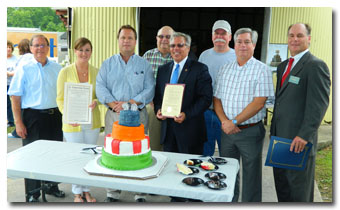ITM Texpo Eurasia 2012, the International Textile Machinery Exhibition, took place from April 21 to
24 in Istanbul, Turkey. Some 1,132 exhibitors from 33 countries filled 85,000 square meters of
fairground space in nine well-organized halls. The Rupp Report spoke to the organizers as well as
to some important exhibitors to get a first impression of the show. Since its start in 2004, the
event has enjoyed continuing growth.
For Necip Güney, marketing and sales director of co-organizer Teknik Fuarcılık Ltd., it was
clear from the start in 2004 that the ITM trade fair should be held in one country for the whole
region. “This year,” he said, “the show was presented in a different way; it was merged with Texpo
Eurasia trade fair, which before took place every year. And our idea was right, the exhibitors were
quite happy with the result of ITM 2012.”
Most of the interviewed exhibitors were happy; however, some had mixed emotions. The first
and second day were considered to be very good, but the third day — which was a national holiday —
was rather poor. “It seems that the Turkish people don’t want to spend a free day from their work
to visit an exhibition,” one exhibitor explained to the Rupp Report. However, the overall results
and the quality of the visitors were judged to be good, and the expectations were fulfilled. A very
big agent of many European top labels explained that this show is the best for him: “Here, we see
not only the decision makers but also the boss, who is spending all the money, and that’s very
important for Asian people.”
Many Different Visitor Countries
According to the organizers, most visitors came from Turkey, of course, as well as from the
Middle East, the Balkans and North Africa. Umit Vural of co-organizer Tüyap Tüm Fuarcılık said,
“The visitors coming from Iraq, Iran, Syria, Egypt, Tunisia and Yemen were showing some kind of
‘Arab Spring.'” At the moment, the Turkish government is supporting the textile industry with a
considerable amount of money. For Vural, the consequences are clear: “Since the beginning of the
industry, the textile industry has been Turkey’s locomotive industry. I’m convinced that this
recent stimulus package has been another motivation and a driving force for a successful show.”
Exhibitors confirmed that many visitors came from Turkey, followed by people from Egypt,
Iran, Syria, Uzbekistan and Ukraine as well as some from Belarus. There is no doubt that Turkey is
the hub and ITM is the gateway to the up-and-coming countries of the Middle East. More than one
exhibitor mentioned the establishment of a high-quality man-made-fiber industry in some Middle East
countries: “Iranians and Syrians are ready to invest,” said one exhibitor. “However, due to the
well-known political problems, they are not able to place the orders.”
Sufficient Feedback
Since the beginning of this year, Turkey’s export figures have been soaring to new heights
every month. The export figures of the first quarter of 2012 show a total of US$12.6 billion, and
the first four months netted US$16 billion. Experts estimate the share of the textile industry
within these first-quarter export figures total some US$4 billion to US$5 billion, underlining the
importance of the textile industry for the national gross domestic product.
Where Are The Weavers?
One exhibitor mentioned that the ITM standard has improved considerably, up to the European
standard. But one thing was quite strange: The big European weaving machinery manufacturers didn’t
show up. The Rupp Report heard many different rumors through the grapevine. One source said they
didn’t show up because Turkey is a knitting country. Another one said there was an agreement among
the absent producers, for whatever reason. Well, probably, the truth will never be discovered.
Important Markets
Of course, all interviewed people confirmed that the Chinese market is still the most
important one, but Turkey has become the second-most important market in the last eight to 10
months, even ahead of India. And the reasons are evident: the stimulus program from the Turkish
government on one side and the internal problems of India on the other side.
No doubt, and this was the unanimous opinion of all interviewed exhibitors, Turkey will
become even more important for the textile machinery manufacturers and the global retailers. The
already mentioned stimulus package is one reason. “But,” said one European exhibitor,
“geographically, Turkey has an outstanding strategic position. It’s moving, vibrant and full of
innovation. On top of that — and this is quite a surprise — there is no bureaucracy like there is
in many other countries. If you want to move something, you can do it fast.” This was confirmed in
another way by a few Turkish textile producers from the yarn and fabric-forming sectors: “Our order
books are full up to the end of 2012, and we look into the year 2013 with confidence.”
May 8, 2012





